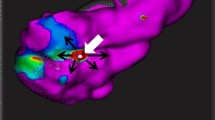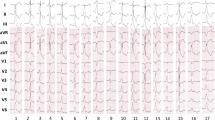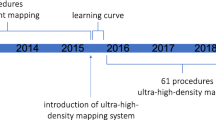Abstract
In verapamil-sensitive left posterior fascicular ventricular tachycardia (LPF-VT), radiofrequency catheter ablation (RFA) is performed targeting mid-to-late diastolic potential (P1) and presystolic potential (P2) during tachycardia. This study included four patients who had undergone electrophysiological study (EPS) and pediatric patients with verapamil-sensitive LPF-VT who had undergone RFA using high-density three-dimensional (3D) mapping. The included patients were 11–14 years old. During EPS, right bundle branch block and superior configuration VT were induced in all patients. VT mapping was performed via the transseptal approach. P1 and P2 during VT were recorded in three of the four patients. All patients initially underwent RFA via the transseptal approach. In three patients, P1 during VT was targeted, and VT was terminated. The lesion size indices in which VT was terminated were 4.6, 4.6, and 4.7. For one patient whose P1 could not be recorded, linear ablation was performed perpendicularly in the area where P2 was recorded during VT. Among the three patients in whom VT was terminated, linear ablation was performed in two to eliminate the ventricular echo beats. In all patients, VT became uninducible in the acute phase and had not recurred 8–24 months after RFA. High-density 3D mapping with an HD Grid Mapping Catheter allows recording of P1 and P2 during VT and may improve the success rate of RFA in pediatric patients with verapamil-sensitive LPF-VT.






Similar content being viewed by others
References
Zipes DP, Foster PR, Troup PJ, Pedersen DH (1979) Atrial induction of ventricular tachycardia: reentry versus triggered automaticity. Am J Cardiol 44:1–8. https://doi.org/10.1016/0002-9149(79)90242-x
Belhassen B, Rotmensch HH, Laniado S (1981) Response of recurrent sustained ventricular tachycardia to verapamil. Br Heart J 46:679–682. https://doi.org/10.1136/hrt.46.6.679
Nogami A, Naito S, Tada H, Taniguchi K, Okamoto Y, Nishimura S, Yamauchi Y, Aonuma K, Goya M, Iesaka Y, Hiroe M (2000) Demonstration of diastolic and presystolic Purkinje potentials as critical potentials in a macro-reentry circuit of verapamil-sensitive idiopathic left ventricular tachycardia. J Am Coll Cardiol 36:811–823. https://doi.org/10.1016/s0735-1097(00)00780-4
Chen H, Chan K, Po SS, Chen M (2020) Idiopathic left ventricular tachycardia originating in the left posterior fascicle. Arrhythm Electrophysiol Rev 8:249–254. https://doi.org/10.15420/aer.2019.07
Nogami A, Phanthawimol W, Haruna T (2022) Catheter ablation for ventricular tachycardia involving the his-purkinje system: fascicular and bundle branch reentrant ventricular tachycardia. Card Electrophysiol Clin 14:633–656. https://doi.org/10.1016/j.ccep.2022.06.003
Lin D, Hsia HH, Gerstenfeld EP, Dixit S, Callans DJ, Nayak H, Russo A, Marchlinski FE (2005) Idiopathic fascicular left ventricular tachycardia: linear ablation lesion strategy for noninducible or nonsustained tachycardia. Heart Rhythm 2:934–939. https://doi.org/10.1016/j.hrthm.2005.06.009
Liu Q, Shehata M, Jiang R, Yu L, Chen S, Zhu J, Ehdaie A, Sovari AA, Cingolani E, Chugh SS, Jiang C, Wang X (2016) Macroreentrant loop in ventricular tachycardia from the left posterior fascicle: new implications for mapping and ablation. Circ Arrhythm Electrophysiol 9:e004272. https://doi.org/10.1161/CIRCEP.116.004272
Matsuura G, Kishihara J, Fukaya H, Oikawa J, Ishizue N, Saito D, Sato T, Arakawa Y, Kobayashi S, Shirakawa Y, Nishinarita R, Horiguchi A, Niwano S, Ako J (2021) Optimized lesion size index (o-LSI): a novel predictor for sufficient ablation of pulmonary vein isolation. J Arrhythm 37:558–565. https://doi.org/10.1002/joa3.12537
Murayama Y, Kishihara J, Fukaya H, Mitani Y, Saito D, Matsuura G, Sato T, Nakamura H, Ishizue N, Oikawa J, Niwano S, Ako J (2023) Lesion size index-guided cavotricuspid isthmus linear ablation. J Interv Card Electrophysiol 66:485–492. https://doi.org/10.1007/s10840-022-01360-4
Themistoclakis S, Calzolari V, De Mattia L, China P, Dello Russo A, Fassini G, Casella M, Caporaso I, Indiani S, Addis A, Basso C, Della Barbera M, Thiene G, Tondo C (2022) In vivo lesion index (LSI) validation in percutaneous radiofrequency catheter ablation. J Cardiovasc Electrophysiol 33:874–882. https://doi.org/10.1111/jce.15442
Parwani AS, Hohendanner F, Bode D, Kuhlmann S, Blaschke F, Lacour P, Heinzel FR, Pieske B, Boldt LH (2020) The force stability of tissue contact and lesion size index during radiofrequency ablation: an ex-vivo study. Pacing Clin Electrophysiol 43:327–331. https://doi.org/10.1111/pace.13891
Calzolari V, De Mattia L, Indiani S, Crosato M, Furlanetto A, Licciardello C, Squasi PAM, Olivari Z (2017) In vitro validation of the lesion size index to predict lesion width and depth after irrigated radiofrequency ablation in a porcine model. JACC Clin Electrophysiol 3:1126–1135. https://doi.org/10.1016/j.jacep.2017.08.016
Morishima I, Nogami A, Tsuboi H, Sone T (2012) Negative participation of the left posterior fascicle in the reentry circuit of verapamil-sensitive idiopathic left ventricular tachycardia. J Cardiovasc Electrophysiol 23:556–559. https://doi.org/10.1111/j.1540-8167.2011.02251.x
Maeda S, Yokoyama Y, Nogami A, Chik WW, Hirao K (2014) First case of left posterior fascicle in a bystander circuit of idiopathic left ventricular tachycardia. Can J Cardiol 30:1460.e11-1460.e13. https://doi.org/10.1016/j.cjca.2014.06.005
Sedmera D, Gourdie RG (2014) Why do we have Purkinje fibers deep in our heart? Physiol Res 63:S9–S18. https://doi.org/10.33549/physiolres.932686
Nogami A, Komatsu Y, Talib AK, Phanthawimol W, Naeemah QJ, Haruna T, Morishima I (2023) Purkinje-related ventricular tachycardia and ventricular fibrillation: solved and unsolved questions. JACC Clin Electrophysiol 26:S2405–S2500. https://doi.org/10.1016/j.jacep.2023.05.040
Acknowledgements
The authors would like to thank Enago (www.enago.jp) for the English language review.
Author information
Authors and Affiliations
Contributions
S.F wrote the main manuscript text. E.K, M.N, TS, YT and YY is pediatric cardiologist and carried out cardiac examination. A.C, and K.U is cardiologist and carried out EPS and RFCA with us. EK, MN, TS, YT, YY, AC, and KU critically reviewed and supervised the manuscript. All authors read and approved the final manuscript.
Corresponding author
Ethics declarations
Conflict of interest
Authors declare that there is no conflict of interest.
Ethical Approval
This study was approved by our institutional ethics committee (No. 64-180), and written informed consent was obtained from the parents.
Additional information
Publisher's Note
Springer Nature remains neutral with regard to jurisdictional claims in published maps and institutional affiliations.
Rights and permissions
Springer Nature or its licensor (e.g. a society or other partner) holds exclusive rights to this article under a publishing agreement with the author(s) or other rightsholder(s); author self-archiving of the accepted manuscript version of this article is solely governed by the terms of such publishing agreement and applicable law.
About this article
Cite this article
Fujita, S., Kabata, E., Nishiyama, M. et al. Efficacy of High-Density Three-Dimensional Mapping for Verapamil-Sensitive Left Posterior Fascicular Ventricular Tachycardia in Pediatric Patients. Pediatr Cardiol 45, 368–376 (2024). https://doi.org/10.1007/s00246-023-03352-1
Received:
Accepted:
Published:
Issue Date:
DOI: https://doi.org/10.1007/s00246-023-03352-1




